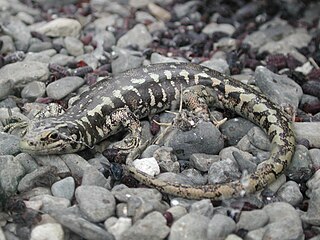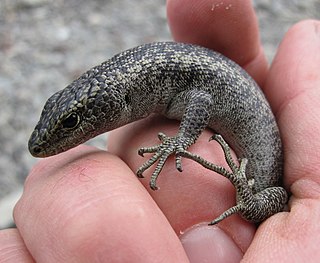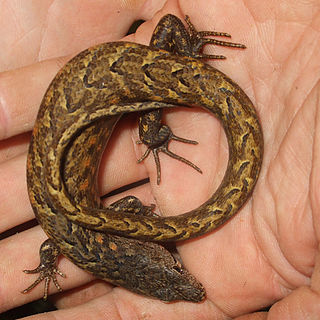
Oligosoma is a genus of small to medium-sized skinks found only in New Zealand, Norfolk Island and Lord Howe Island. Oligosoma had previously been found to belong to the Eugongylus group of genera in the subfamily Lygosominae; the Australian genus Bassiana appears to be fairly closely related.

The long-toed skink is a species of skink of the family Scincidae, endemic to New Zealand. It was first described by Geoff Patterson in 1997. It is only known from a few sites in the South Island of New Zealand and little is known of its habits. It seems to prefer dry, rocky habitats, usually eroding stream terraces or scree slopes. It is diurnal and heliothermic. Maximum snout-vent length is about 70 mm.

The scree skink is a species of skink native to several sites throughout the South Island of New Zealand. A member of the family Scincidae, it was described by Geoff Patterson in 1997. It favours rocky habitats, particularly greywacke screes. Threats to scree skinks include predation by introduced mammals, weed encroachment, human interference and severe flood events.

The grand skink is an endangered species of large skink endemic to the central Otago region of New Zealand.

Whitaker's skink, also known commonly as Whitaker's New Zealand skink, is an endangered species of skink, a lizard in the family Scincidae. The species is found only in New Zealand.

The chevron skink is a large species of skink that is endemic to New Zealand. Previously found across Northland and the northern Auckland Region, it is now found only on the Great Barrier and Little Barrier islands in the Hauraki Gulf. A cryptic forest dweller, it can hide underwater. The chevron skink is the longest species of skink in New Zealand, reaching lengths of up to 340 mm (13 in). It is under threat from introduced rats.

Oligosoma infrapunctatum, the speckled skink, is a species of skink in the family Scincidae. It is endemic to New Zealand.

The small-scaled skink is a species of skink in the family Scincidae. The first specimen was captured in 1971 on Motutaiko Island, Lake Taupō but it is now known to be endemic to the central North Island of New Zealand in small population pockets. The holotype is in the collection of the Museum of New Zealand Te Papa Tongarewa.

Oligosoma taumakae, the Open Bay Island(s) skink, or Taumaka skink, is a species of skink. It was described from the Open Bay Islands, off the west coast of the South Island of New Zealand.

The slight skink is a skink of the family Scincidae, endemic to the far north of the North Island of New Zealand. The precise distribution is unknown; currently it is only known from localities in the Te Paki region of Northland. It closely resembles the copper skink, Oligosoma aeneum, and was considered to be a member of this species until recently when it was described as a new species using morphological, allozyme and DNA methods. O. levidensum is difficult to distinguish morphologically from O. aeneum, which is probably why it had not been recognised until recently. The main distinguishing feature is the slighter overall body form of O. levidensum compared to O. aeneum. The limbs of O. levidensum are reduced compared to O. aeneum and O. hardyi, the other members of the O. aeneum complex.

The ornate skink is a rare species of skink endemic to New Zealand. Once widespread across the North Island, habitat destruction and predation by introduced species has now reduced their range to scattered localities throughout the North Island and offshore islands.

The Sinbad skink is a rare species of medium-sized skink endemic to New Zealand where it lives in an alpine habitat in Sinbad Gully, in Fiordland National Park.

The Barrier skink is a species of medium-sized skink, a lizard in the subfamily Eugongylinae of the family Scincidae. The species is endemic to New Zealand, where it lives in the alpine habitat of the Darran and Takitimu Mountains of Fiordland. It is one of only two species of New Zealand skinks that live exclusively in the alpine zone, the other being the "Sinbad skink", Oligosoma pikitanga, a closely related species of similar appearance which is found in the same part of the South Island. The Barrier skink was first collected in the 1960s but was overlooked until rediscovery by a pair of mountain climbers in 2005; the species was scientifically described in 2009.

The Te Kakahu skink is a critically endangered species of skink native to New Zealand. When discovered, the entire species was inhabiting a single patch of clifftop vegetation on Chalky Island in Fiordland National Park.

The Burgan skink is a nationally endangered species of skink native to New Zealand. It was described from a specimen found near the Burgan Stream, in the Rock and Pillar Range, Central Otago.

The Eyres skink is a nationally vulnerable species of skink native to New Zealand. It is named in honour of the location of its habitat, the Eyre Mountains.

The cryptic skink is a nationally vulnerable species of skink native to New Zealand.

The Nevis skink is a nationally vulnerable species of skink native to New Zealand. It is named in honour of the location of its habitat, the Nevis valley.

The common skink, also known as the northern grass skink, is a species of skink native to New Zealand. Although historically classified as a subspecies of Oligosoma nigriplantare, it is likely to be given separate species status as data suggests it is a distinct species.

The brown skink is a species of skink native to New Zealand.






















